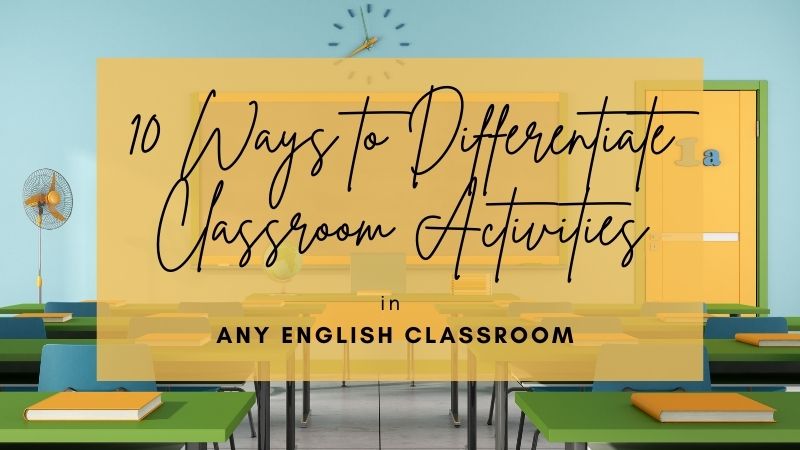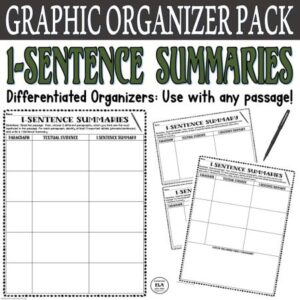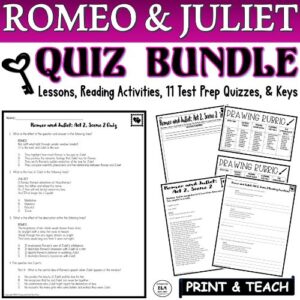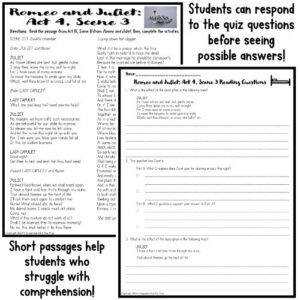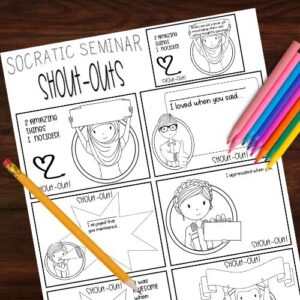Differentiation is THE KEY word in education today. Every teacher wants a classroom that is differentiated to meet the needs of every student; however, it really is an impossible feat. An educator can always try to differentiate classroom lessons, worksheets, environments, etc., but many times, it is a crapshoot. Sometimes, strategies work, and sometimes, they simply don’t.
Plus, can you imagine trying to create lessons every day that take into account every learning style, personality, reading level, writing ability, etc.? Once again, quite impossible!
We can only do our very best to differentiate classroom activities, assignments, quizzes, and more. So let’s make this process as EASY and STRESS-FREE as possible. Keep reading for 10 Ways to Differentiate Classroom Activities and Lessons!
Need help with Test Prep? Check out this FREE Pack of 3 Test Prep Activities to help students achieve success on standardized tests!
10 Ways to Differentiate Classroom Activities
1. Assessments
Instead of creating something entirely new for a struggling reader, let’s try to use what we already have when it comes to assessments.
For example, if you have a quiz for “The Tell-Tale Heart,” you don’t have to give the same exact quiz to every student. You could change it up!
- Give 5 or 10 questions instead of 20 questions for students who usually need extra time.
- Only assign questions linked to the standards a student or group of students is struggling in.
- Offer a digital version instead of a paper version.
- Let students use the passage to answer the questions.
- Provide a written response option instead of a multiple-choice quiz.
- Allow student pairs or groups to work together on several questions.
- Encourage students to retake the assessment if needed.
Click below to check out a quiz pack with differentiated options for “The Tell-Tale Heart!”
2. Writing
Now, in college, I had several professors who told me that I should never really grade my students’ grammar. Well, this thinking is faulty if we ultimately want our students to succeed in the working world.
In the case of wanting to differentiate classroom writing assignments, I am not talking about making an assignment easier. I want all my students to meet the standards. What could this look like?
If the goal is to write a narrative essay, you can provide many opportunities to achieve this goal:
- Write a 5-6 paragraph narrative.
- Write an “About Me” website page for your “future” business.
- Write a narrative voiceover for a movie about your life.
- Write an epic narrative poem.
- Write a speech that includes a narrative.
When it comes to writing shorter responses, feel free to provide options as well. You could ask for a 1-sentence statement, require 1 or more pieces of evidence, or encourage students to write 1 paragraph instead of 2!
3. Differentiate Classroom Graphic Organizers
If you have some go-to organizers students can use for any text, it will make the process of differentiating classroom lessons easier.
Here are 3 examples based on writing a 1-sentence summary:
Click the image above to get this organizer pack, so you can PRINT & TEACH!
4. Texts and Passages
You don’t have to teach the same texts for every class or even every student. Even better, you might reach more students when you integrate varied forms of similar texts.
For instance, let’s say you want to teach Romeo and Juliet. You could rotate in various options:
- The classic play-whole, certain acts, or excerpts
- A modern revision and/or a No Fear version
- Graphic novel
- 1968 Movie Scenes
- Leonardo DiCaprio Movie version
- Audio play
Reading the whole play might be optimal, but with struggling readers, it can be a very long process. By integrating all of the above options, you are differentiating for pretty much ALL of your students!
Want to make differentiation SIMPLE and EASY as you teach Romeo and Juliet? Check out this quiz bundle with 2 quizzes for each act!
5. Movement
My nephew finds it difficult to stay seated. It is not because he is necessarily hyperactive; he is simply a young kid with a lot of energy. To make it just a tad easier for him, my sister who homeschools will let him learn in several ways:
- He can take a break away from the main table for several minutes at a time.
- He can stand.
- He can sway back and forth.
- He can get a snack.
- He can run outside for 10 minutes.
- He can sit on the couch.
- He can lie down on his bed. ***Mostly when reading***
Now, I know we cannot allow students to do all of these things. It would be nice, however, to provide some options for movement throughout a class period, especially one that is 60 minutes or longer.
I offer the following options for my own students:
- Stand by your table or desk (The caveat is you cannot distract others.)
- Get up to go to the bathroom.
- Grab a snack from your backpack. (Of course, this policy depends on admin.)
- Move to another desk or location in the room.
6. Differentiate Classroom Lessons
- Create a list of IEP/504 strategies/accommodations within each lesson. If you have the list in every lesson and a link to each activity, you can easily justify how you supported and taught your students. This process saved me loads of time and headaches at the end of the grading period.
- Vary the activities. Sometimes as teachers, just like our students, we get stuck in a rut teaching the same way over and over again. To help differentiate, list several activity options within your lessons!
- Include multiple standards. Most lessons lend themselves to teaching multiple standards. For example, if you are reading a fun short story like “Click Clack the Rattle Bag,” you could easily cover the central idea/theme, citing evidence, words and phrases, and structure. Plus, you could end on a writing activity that links to planning, outlining, and writing a narrative end to the story! That’s like 7 standards in 1 single lesson. By conducting your lesson in this way, you get to address many students’ struggles!
- List the teaching steps with extended ideas. You can always shorten a lesson if a group of students needs more time; however, it is difficult to lengthen a lesson for your students who are mastering the goal standards. Always have an extra or extended assignment or two to meet the needs of these students!

7. Discussions
I am a HUGE fan of Socratic Seminars. I am not a big fan of simply having a class discussion. In a class of 30 students, you will either get 1) silence or 2) like 5 students who talk the whole time.
Instead, I like to differentiate classroom discussions and develop them into more rigorous and purposeful Socratic Seminars:
- Whole Group Seminars: Personally, I think this type is the least effective. If you have 30+ students and the class is 60-90 minutes long, there is not a lot of time for everyone to participate. This is most especially true when 5 or 6 students dominate the discussion.
- Half-Class Seminars: I really like this way of conducting a seminar. You can divide your students into pairs. If you have 30 students, 15 will participate for 10 minutes at a time and then switch out. This process definitely lets students who are quieter get into the action.
- Small Group —> Lead to Whole-Group Seminars: So this type is my favorite, and my students have the most fun in this type of seminar. It does, however, require lots of discipline when you start out. 1) Divide a class of 30 students into 5 or 6 groups. 2) Put the groups on the outside of the main discussion circle. 3) One student from each group participates at a time. 4) After 5 minutes, let 1 student from each group sub out, or after each student talks/participates, he/she can silently trade out with another person in the group. ***If a group member sits there without talking for a while, feel free to tell him/her that another turn will come around.
- Pair Seminars: After pairs of students conference with each other, you could spotlight each pair for a minute to five minutes of discussion. This type of seminar might be helpful as an exemplar discussion to give students an idea of how to participate.
Ways to prepare:
- Let students create the questions ahead of time.
- Encourage students to underline evidence or ideas from passages that will guide the discussion.
- Use question stem templates.
- Practice ahead of time in small groups.
- Allow students to work together to gather their ideas in the early stages of attempting Socratic Seminars.
***At the end of a Socratic Seminar, include a time of reflection/shout-outs!
8. Bell-Ringers / Close of Day
Starting and ending each day with a purpose is incredibly important. Your students need to know what your expectation is. Fortunately, however, not everything has to be the same!
5-Day Bell Ringer Rotation-
- Start out with a journal question: Ex. If you are teaching “Thank You, Ma’am” by Langston Hughes, you could have students think about a time that they were shown kindness. You could also require students to respond in the following ways: 1) Craft a paragraph response. 2) Create an image. 3) Write down synonyms/antonyms for “kind.”
- Analyze a quote: Pick a quote related to a text you are reading. Then, students can analyze the quote in some way. 1) They could change a word in the quote and explain how the meaning changes. 2) They could summarize the quote. 3) They could AGREE or DISAGREE with the quote and support their ideas with evidence.
- Teach a vocabulary word: I am a big fan of learning vocabulary through reading and conversation. Why not have students learn a word or two from the passage you are analyzing that day?
- Learn grammar rules: By all means, please teach grammar. You don’t have to teach the concept in isolation. Let’s say you want students to learn how to use a semicolon. Provide 2 sentences about a story. Have them combine the sentences using a semicolon!
- Reflection: Encourage students to reflect on their week. What did they learn from the story? What new skills did they learn? What message did they receive from the text?
5-Day Close of Day Rotation-
- Remind students to turn in the assignment: This option may sound pretty basic, but so many students need reminders. Like all of the time.
- Exit-Ticket: Link to whatever standard you are covering for the day. Ex. Central Idea-What is the main idea of the story? / Theme-What lesson does the protagonist learn?
- Check-In: A simple teacher check-in and/or conference chat can help students stay on task. It can even be a grade.
- Reflection: What have you learned today? Tell me 1, 2, or 3 things!
- Connect to Tomorrow: Introduce what you will cover next. If it is a poem, maybe have students listen to a song with a similar subject to end the day!
All of these can check the box when you decide to differentiate classroom procedures!
9. Reading Strategies
By keeping an arsenal of reading strategies close by, your students can experiment with the strategies that work for them.
These are my favorites to use on a daily/weekly basis:
- Set a goal for reading
- Read the first and last sentences of every paragraph
- Highlight to go back
- Annotate to explain
- Constantly question
- Reread the text
- Summarize after reading
- Visualize the text
- Read aloud
- Flag any confusing ideas
Click below to read about 30 Reading For Comprehension Strategies!
10. Groups
When I was in grade school, I experienced a row-by-row classroom with whole-group instruction. There is value to this structure. Teachers in the 80s and 90s experienced a different type of classroom. There was a high level of discipline required by teachers, admin, and parents. We also had smaller classes, so if one student chose not to listen, it was incredibly obvious.
Nowadays, our classrooms are quite different. You have a lot of options when it comes to grouping your students for differentiation:
- Whole-Group: You can stick to whole-group instruction, discussions, activities, etc., depending on the needs of your students.
- Half-Group: You might want to split up your students based on various reasons. Half of your students could be working on an activity for the main idea and the other half is learning about the author’s purpose.
- Small Group: In the case of trying to work with small groups, I would stick to no more than five or six students. This type of group is ideal when remediating for a specific skill or standard.
- Pairs: I love using pairs in the classroom. You can let students choose, pair up students randomly, or pair by level/varied level.
- Individuals: I know this choice may not be the favorite of most educational researchers; however, never underestimate a student’s choice to work alone. I have been, like most of us, a victim of group work. And I can tell you that I would have loved to just work alone on something. If a student desires to do so and that student is productive and effective, by all means, let a student make this choice!
Why should you differentiate classroom lessons and activities every day?
When we reflect on why we became teachers, we typically come back to the idea that we want our students to learn and succeed beyond the classroom! By including differentiation as a staple in your classroom, it will become second nature for both you and your students in no time!
Crave more ideas to differentiate classroom lessons and activities? Check out 7 Strategies of Differentiation in the English Classroom!
Need more fun lessons and activities that incorporate good literature? Check out my store Kristin Menke-Integrated ELA Test Prep!

